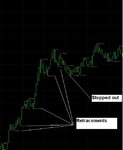pedro01
Guest
- Messages
- 1,058
- Likes
- 150
I'm working on the framework code and educating myself on various techniques like GP, and am not at the stage of developing complete systems.
I agree on the dangers of blindly finding systems with no trading rationale behind them - it's one of the top things to bear in mind and avoid. "Correlation doesn't imply causation". I think of a graph with 2 axes, level of correlation & level of rationale, where you can position trading systems. High correlation, low rationale = curve-fitted system (butter production in Bangladesh predicts the SP500). Low correlation, high rationale = 'proper' trading idea that 'should' work but doesn't ("this market's oversold and P/Es are on the floor, it *must* rise").
Like anything, there are intelligent and unintelligent ways to do this; because many/most people do system development unintelligently, it gets a bad rep.
I agree.
We got our system integrated yesterday at around midday and it racked up $629.15 in profits over 6 long trades & 1 short trade before close out time. That's on a $25k DEMO account with 1% risk per trade - which is spread across a basket of 5 stocks. Obviously it's too early to run with real $$$.
Now to run it for a few months to get the glitches out & tune it. We have some more rules to add in too but the basic system is there.
No conclusions can be drawn from 1 day of trading but it's nice to start off on a high.

